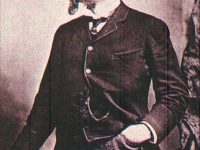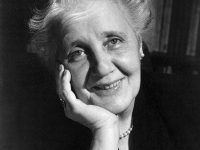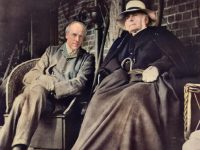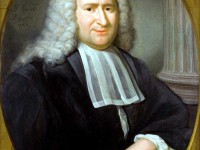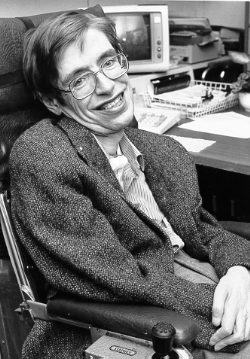
Stephen Hawking (1942 – 2018)
When I read the news that Stephen Hawking passed away, I was rather sad. I grew up with a fascination for astronomy and cosmology. Trying to understand the fabrics and working of the universe, I devoured his popular books and articles and I am rather thankful. Amongst others it was foremost this unique physicist, who planted the seed for my decision to become a scientist myself. However, I abandoned physics after high school and turned towards computer science for my scientific career. Nevertheless, thank you Stephen Hawking for your scientific contributions and most of all your inspiration!
On January 8, 1942, English theoretical physicist, cosmologist and author Stephen William Hawking was born. Hawking’s principal areas of research are theoretical cosmology and quantum gravity. His scientific works include a collaboration with Roger Penrose on gravitational singularity theorems in the framework of general relativity,[4] and the theoretical prediction that black holes emit radiation, often called Hawking radiation. Hawking was the first to set forth a theory of cosmology explained by a union of the general theory of relativity and quantum mechanics.
“My goal is simple. It is a complete understanding of the universe, why it is as it is and why it exists at all.”
— Stephen Hawking, as quoted in [8], Ch. 7 : The Final Question, p. 77
Stephen Hawking – Youth and Education
Stephen Hawking was born in Oxford, England, as the eldest son of four siblings to Frank Hawking, a medical researcher, and his wife Isobel Hawking, a secretary at his father’s medical research institute. In 1950, the family moved to St Albans, where his father became head of the division of parasitology at the National Institute for Medical Research. Hawking’s father advised his son to study medicine in contrary to Stephen’s original desire to study mathematics. He wanted Hawking to attend University College, Oxford, his own alma mater. As it was not possible to read mathematics there at the time, Hawking decided to study physics and, more specifically, cosmology.
By his own account, Hawking didn’t put much time into his studies. Nevertheless, in 1962, he graduated with honors in natural science and went on to attend Trinity Hall at Cambridge University for a PhD in cosmology. However, after being diagnosed with motor neurone disease, Hawking fell into a depression; though his doctors advised that he continue with his studies, he felt there was little point. However, his disease progressed more slowly than doctors had predicted. Although Hawking had difficulty walking unsupported and his speech was almost unintelligible, an initial diagnosis that he had only two years to live proved unfounded. Yet, Hawking defied the odds, not only attaining his PhD but also forging new roads into the understanding of the universe in the decades since.[2]
ALS and Academic Career
Hawking had a rare early-onset slow-progressing form of amyotrophic lateral sclerosis (ALS) that has gradually paralysed him over the decades. After completing his doctorate in 1966 Hawking was awarded a fellowship at Gonville and Caius College, Cambridge. At first his position was that of Research Fellow, but later he became a Professorial Fellow at Gonville and Caius College. In 1973 he left the Institute of Astronomy and joined to the Department of Applied Mathematics and Theoretical Physics at Cambridge. He became Professor of Gravitational Physics at Cambridge in 1977. In 1979 Hawking was appointed Lucasian Professor of Mathematics at Cambridge. The man born 300 years to the day after Galileo died now held Newton’s chair at Cambridge.[3,7]
Singularities and Hairy Black Holes
Between 1965 and 1970 Hawking worked on singularities in the theory of general relativity devising new mathematical techniques to study this area of cosmology. Much of his work in this area was done in collaboration with Roger Penrose who, at that time, was at Birkbeck College, London. From 1970 Hawking began to apply his previous ideas to the study of black holes during which he discovered a remarkable property.[4] Using quantum theory and general relativity he was able to show that black holes can emit radiation. His success with proving this made him work from that time on combining the theory of general relativity with quantum theory. In 1971 Hawking investigated the creation of the Universe and predicted that, following the big bang, many objects as heavy as 109 tons but only the size of a proton would be created. These mini black holes have large gravitational attraction governed by general relativity, while the laws of quantum mechanics would apply to objects that small.[3]
In 1974, he developed the concept of “Hawking radiation“, according to which black holes in quantum field theory (more or less fast, depending on the mass of the black hole) destroy each other. At that time he tried to understand the concept of the entropy of black holes introduced by Jacob Bekenstein in 1973 quantum-mechanically and found to his own surprise that black holes could be assigned a radiation – one of his most important discoveries.
In 2004, Hawking announced that he had solved the problem of the loss of information in black holes, but this was met with criticism. The problem is the following. Black holes “swallow” matter and thus information. However, according to the classical description by General Relativity, they themselves are only defined by a few parameters and are sources of thermal radiation in quantum theory, as Hawking had shown. The only “information” is their temperature and entropy, which is proportional to their surface. Information is thus destroyed. In quantum mechanics, this corresponds to a “nonunitary” time evolution that does not preserve probabilities, which runs counter to the principles of quantum mechanics.
“I’m sorry to disappoint science fiction fans, but if information is preserved, there is no possibility of using black holes to travel to other universes. If you jump into a black hole, your mass energy will be returned to our universe but in a mangled form which contains the information about what you were like but in a state where it can not be easily recognized. It is like burning an encyclopedia. Information is not lost, if one keeps the smoke and the ashes. But it is difficult to read.”
— Stephen Hawking [9]
A Brief History of Time
In 1984 Hawking wanted to publish a popular book on cosmology and soon had produced a first draft of A Brief History of Time, which was published in 1988 and appeared on the British Sunday Times best-seller list for a record-breaking 237 weeks. In 2002 Hawking published On the shoulders of giants. The great works of physics and astronomy. This book, which he edited, contains reprints of nearly complete editions of: Copernicus, On the revolution of the heavenly spheres (1543)[10]; Galileo, Dialogues concerning two new sciences (1638); Kepler, Harmony of the world (Book Five) (1618)[11]; Newton, Principia (1687)[12]; and seven papers on relativity by Einstein.[3,13] Hawking continued his writings for a popular audience, publishing The Universe in a Nutshell in 2001, A Briefer History of Time in 2005, and God Created the Integers, which appeared in 2006.
In 1974 the Royal Society elected Hawking as one of its youngest fellows. Hawking was made a Commander of the British Empire (CBE) in 1982 and a Companion of Honour in 1989. He also received the Copley Medal from the Royal Society in 2006 and the U.S. Presidential Medal of Freedom in 2009. Stephen Hawking died at his home in Cambridge, England, on 14 March 2018, at the age of 76.
Stephen Hawking speaks at MIT – Education and Technology Sept. 1994, [15]
References and Further Reading:
- [1] Stephen Hawking, at Biography.com
- [2] Nola Taylor Redd: Stephen Hawking Biography, at Space.com
- [3] O’Connor, John J.; Robertson, Edmund F., “Stephen Hawking“, MacTutor History of Mathematics archive, University of St Andrews.
- [4] Sir Roger Penrose and the Singularity, SciHi blog, August 8, 2015.
- [5] Stephen Hawking, British physicist, at Britannica Online
- [6] Stephen Hawking’s official website
- [7] Standing on the Shoulders of Giants – Sir Isaac Newton, SciHi Blog
- [8] John Boslough, Stephen Hawking’s Universe, HarperCollins, 1989
- [9] Stephen Hawking, Information Loss in Black Holes, 2005, 10.1103/PhysRevD.72.084013
- [10] Nikolaus Copernicus and the Heliocentric Model, SciHi Blog
- [11] And Kepler Has His Own Opera – Kepler’s 3rd Planetary Law, SciHi Blog
- [12] Sir Isaac Newton and the famous Principia, SciHi Blog
- [13] How Albert Einstein Revolutionized Physics, SciHi Blog
- [14] Stephen Hawking at Wikidata
- [15] Stephen Hawking speaks at MIT – Education and Technology Sept. 1994, MIT Video Productions @ youtube
- [16] Timeline for Stephen Hawking, via Wikidata

